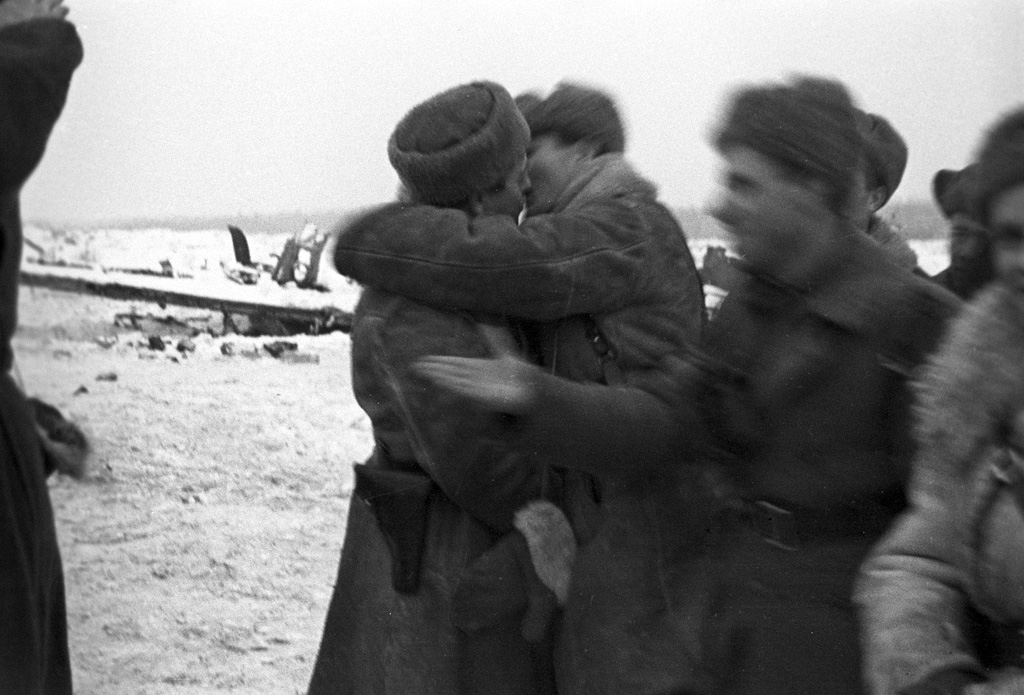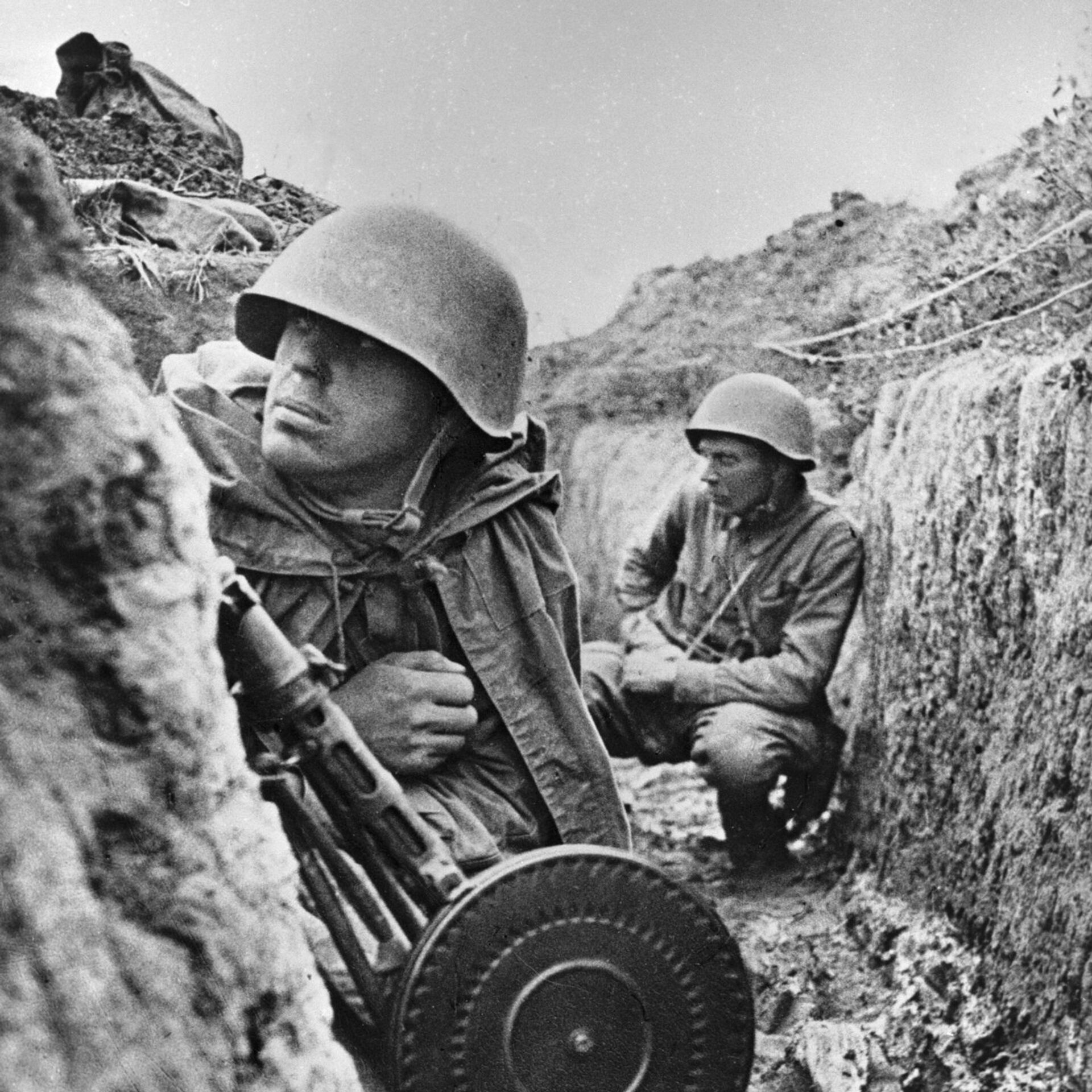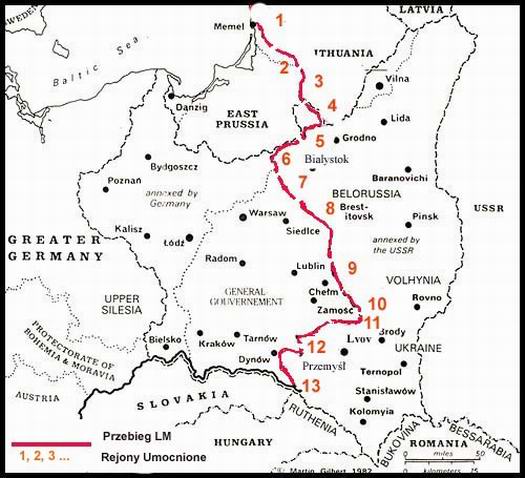|
364th Rifle Division
The 364th Rifle Division was an infantry division of the Red Army during World War II. It began forming on August 10, 1941, as a standard Red Army rifle division at Omsk. It did not reach the front until March 1942, assigned to the 1st Shock Army in Northwestern Front. It served under these commands until September, then was pulled out of the line for rebuilding before being moved north to 8th Army of Volkhov Front. The division remained in Volkhov Front until the Front was disbanded in February 1944, fighting in Operation Iskra, which partly broke the siege of Leningrad, and then in the Leningrad-Novgorod Offensive, which completed the task, and won a battle honor. During the spring-summer 1944 it advanced through the Baltic States, being so worn down in the process that in September it was again moved to the reserves to be returned to a viable strength. In October it was reassigned to the 3rd Shock Army, and would advance with that Army through Poland and into Germany in 1945. ... [...More Info...] [...Related Items...] OR: [Wikipedia] [Google] [Baidu] |
Red Army Flag
Red is the color at the long wavelength end of the visible spectrum of light, next to orange and opposite violet. It has a dominant wavelength of approximately 625–740 nanometres. It is a primary color in the RGB color model and a secondary color (made from magenta and yellow) in the CMYK color model, and is the complementary color of cyan. Reds range from the brilliant yellow-tinged scarlet and vermillion to bluish-red crimson, and vary in shade from the pale red pink to the dark red burgundy. Red pigment made from ochre was one of the first colors used in prehistoric art. The Ancient Egyptians and Mayans colored their faces red in ceremonies; Roman generals had their bodies colored red to celebrate victories. It was also an important color in China, where it was used to color early pottery and later the gates and walls of palaces. In the Renaissance, the brilliant red costumes for the nobility and wealthy were dyed with kermes and cochineal. The 19th century brou ... [...More Info...] [...Related Items...] OR: [Wikipedia] [Google] [Baidu] |
1st Belorussian Front
The 1st Belorussian Front ( Russian: Пéрвый Белорусский фронт, ''Perviy Belorusskiy front'', also romanized " Byelorussian") was a major formation of the Soviet Army during World War II, being equivalent to a Western army group. The 1st Belorussian Front along with the 1st Ukrainian Front were the largest and most powerful among all Soviet fronts, as their main effort was to advance on the Nazi German capital Berlin. Creation and initial operations Initially, the Belorussian Front was created on 20 October 1943 as the new designation of the existing Central Front. It was placed under the command of General Konstantin K. Rokossovsky, who had been commanding the Central Front. It launched the Gomel-Rechitsa Offensive in 1943 and then the Kalinkovichi-Mozyr Offensive in 1944. Redesignation and 1944 operations It was then renamed the 1st Belorussian Front (1BF) on 17 February 1944 following the Dnieper–Carpathian Offensive. A few days later, on 21 F ... [...More Info...] [...Related Items...] OR: [Wikipedia] [Google] [Baidu] |
Sinyavino, Leningrad Oblast
Sinyavino (russian: Синя́вино) is an urban locality (an urban-type settlement) in Kirovsky District of Leningrad Oblast, Russia, located several kilometers inland from the southern shore of Lake Ladoga, east of St. Petersburg and east from Kirovsk. Municipally it is incorporated as Sinyavinskoye Urban Settlement, one of the eight urban settlements in the district. Population: History The selo of Sinyavino was created in the beginning of the 18th century, when Peter the Great gave the lands in the area to his military officer Naum Senyavin. The selo was destroyed during World War II and never restored, but the name was transferred in the 1920s to the settlement which was serving peat production. The settlement of Sinyavino was at the time located in Leningradsky Uyezd of Leningrad Governorate. On August 1, 1927, the uyezds were abolished and Mginsky District, with the administrative center in Mga, was established. The governorates were also abolished, ... [...More Info...] [...Related Items...] OR: [Wikipedia] [Google] [Baidu] |
2nd Shock Army
The 2nd Shock Army (russian: 2-я Ударная армия) was a field army of the Soviet Union during the Second World War. This type of formation was created in accordance with prewar doctrine that called for Shock Armies to ''overcome difficult defensive dispositions in order to create a tactical penetration of sufficient breadth and depth to permit the commitment of mobile formations for deeper exploitation.'' However, as the war went on, Shock Armies lost this specific role and reverted, in general, to ordinary frontline formations. Formation The 2nd Shock Army was formed from the Volkhov Front's 26th Army in December 1941 and initially consisted of the 327th Rifle Division and eight separate rifle brigades. During the Lyuban offensive operation in early 1942, the 2nd Shock Army broke through German lines, was cut off from reinforcement along the Volkhov River by a German counter-attack, and was not permitted to retreat. When the order for retreat finally came in, the 2nd ... [...More Info...] [...Related Items...] OR: [Wikipedia] [Google] [Baidu] |
Georgy Zhukov
Georgy Konstantinovich Zhukov ( rus, Георгий Константинович Жуков, p=ɡʲɪˈorɡʲɪj kənstɐnʲˈtʲinəvʲɪtɕ ˈʐukəf, a=Ru-Георгий_Константинович_Жуков.ogg; 1 December 1896 – 18 June 1974) was a Soviet general and Marshal of the Soviet Union. He also served as Chief of the General Staff, Minister of Defence, and was a member of the Presidium of the Communist Party (later Politburo). During World War II, Zhukov oversaw some of the Red Army's most decisive victories. Born to a poor peasant family from central Russia, Zhukov was conscripted into the Imperial Russian Army and fought in World War I. He served in the Red Army during the Russian Civil War. Gradually rising through the ranks, by 1939 Zhukov had been given command of an army group and won a decisive battle over Japanese forces at Khalkhin Gol, for which he won the first of his four Hero of the Soviet Union awards. In February 1941, Zhukov was ap ... [...More Info...] [...Related Items...] OR: [Wikipedia] [Google] [Baidu] |
Leningrad Front
The Leningrad Front (russian: Ленинградский фронт) was formed during the 1941 German approach on Leningrad (now Saint Petersburg) by dividing the Northern Front into the Leningrad Front and Karelian Front on August 27, 1941. History The Leningrad Front was immediately given the task of containing the German drive towards Leningrad and defending the city from the approaching Army Group North. By September 1941, German forces to the south were effectively stopped on the outskirts of Leningrad, initiating the two-and-a-half-year-long siege of Leningrad. Although Finnish forces to the north stopped at the old Finnish–Soviet border, the Leningrad front suffered severe losses on the Finnish Front. From September 8, soldiers of the front were forced to conduct operations under the conditions of a blockade, with very little supply. Some supplies did reach the city however via the lake Road of Life. During the blockade, the front executed various offensive and ... [...More Info...] [...Related Items...] OR: [Wikipedia] [Google] [Baidu] |
8th Army (Soviet Union)
The 8th Army was a field army of the Soviet Red Army during the Second World War. Winter War The 8th Army was formed in October 1939 (or 14 September 1939) from the Novgorod Army Operational Group of the Leningrad Military District with the task of providing security of the Northwestern borders of the USSR. (The Novgorod Group had been created a month before, on 13 August 1939 by the order No. 0129 of the Chairman of the People's Commissariat for Defence, Marshal of the Soviet Union K.E. Voroshilov. The Group was created for operations in Estonia and Latvia.) On 30 November 1939 the Soviet Union attacked Finland in the Winter War. The strength of the 8th Army, or overall the Red Army, in the north of Lake Ladoga (Ladoga Karelia), surprised the Finnish general staff. The Finns deployed only two divisions, and they had a support group of three brigades, bringing their total strength to over 30,000 uniforms. The Soviets had a division for almost all roads leading west ... [...More Info...] [...Related Items...] OR: [Wikipedia] [Google] [Baidu] |
Demyansk
Demyansk (russian: Демя́нск) is an urban locality (a work settlement) and the administrative center of Demyansky District of Novgorod Oblast, Russia, located along the Yavon River. Municipally, it is incorporated as Demyanskoye Urban Settlement, the only urban settlement in the district. Population: History Demyansk was first mentioned in a chronicle in 1406 as Demon. The area was a part of Derevskaya Pyatina of Novgorod. Demon was a fortress protecting a waterway from Lake Ilmen upstream the Pola and the Yavon to Lake Seliger. The fortress was located close to the boundary between the Novgorod Republic and the Grand Duchy of Moscow, and it was at least twice sieged by Muscovite troops. In 1441, the Muscovites did not manage to conquer Demon, but in the 1470s they conquered and destroyed the fortress. After the subsequent fall of Novgorod, Demon was transferred to the Grand Duchy of Moscow. In the 17th century, Demon went into decline, and a new settlement was founded ... [...More Info...] [...Related Items...] OR: [Wikipedia] [Google] [Baidu] |
1st Shock Army
The 1st Shock Army (russian: 1-я ударная армия) was a field army established by the Soviet Union's Red Army during World War II. The 1st Shock Army was created in late 1941 and fought in the northern areas of Russia and the Baltic States until the surrender of Germany in 1945. The Army was created in accordance with prewar doctrine that called for Shock Armies to 'overcome difficult defensive dispositions in order to create a tactical penetration of sufficient breadth and depth to permit the commitment of mobile formations for deeper exploitation.' However, as the war went on, Shock Armies lost this specific role and reverted, in general, to ordinary frontline formations. History The 1st Shock Army was formed as part of the Reserve of the Supreme High Command (RVGK, the Stavka reserve) at Zagorsk (now Sergiyev Posad) in the Moscow Military District in November 1941. Taking part in the Battle of Moscow in December 1941, on 1 December the Army consisted of the 133r ... [...More Info...] [...Related Items...] OR: [Wikipedia] [Google] [Baidu] |
Reserve Of The Supreme High Command
The Reserve of the Supreme High Command (Russian: Резерв Верховного Главнокомандования; also known as the ''Stavka'' Reserve or RVGK ( ru , РВГК)) comprises reserve military formations and units; the Stavka Reserve acted as the principal military reserve of the Soviet Red Army during World War II, and the RVGK now operate as part of the Russian Armed Forces under the control of the Supreme Commander-in-Chief of the Russian Armed Forces ( ru , Верховный главнокомандующий) - the President of the Russian Federation. History World War II Forces from the Reserve were assigned by the ''Stavka'' (Supreme High Command) to individual '' fronts'' (army groups) that were conducting major operations. These formations were designed to support any forms of operations but especially penetrations and exploitations in accordance with the Soviet deep battle doctrine. Beginning in 1943, the formations and units in the Reserve ... [...More Info...] [...Related Items...] OR: [Wikipedia] [Google] [Baidu] |
NKVD
The People's Commissariat for Internal Affairs (russian: Наро́дный комиссариа́т вну́тренних дел, Naródnyy komissariát vnútrennikh del, ), abbreviated NKVD ( ), was the interior ministry of the Soviet Union. Established in 1917 as NKVD of the Russian Soviet Federative Socialist Republic, the agency was originally tasked with conducting regular police work and overseeing the country's prisons and labor camps. It was disbanded in 1930, with its functions being dispersed among other agencies, only to be reinstated as an all-union commissariat in 1934. The functions of the OGPU (the secret police organization) were transferred to the NKVD around the year 1930, giving it a monopoly over law enforcement activities that lasted until the end of World War II. During this period, the NKVD included both ordinary public order activities, and secret police activities. The NKVD is known for its role in political repression and for carrying out the Great ... [...More Info...] [...Related Items...] OR: [Wikipedia] [Google] [Baidu] |
362nd Rifle Division (Soviet Union)
The 362nd Rifle Division began forming on 10 August 1941, as a standard Red Army rifle division, at Omsk. It didn't reach the front until March 1942, assigned to the 22nd Army in Kalinin Front. It served under these commands for the next year, then was pulled out of the line for rebuilding before being moved south to 3rd Army of Bryansk Front, and later Belorussian Front, for the 1943 summer offensive, during which it was awarded the Order of the Red Banner. It served in 50th Army during Operation Bagration, and earned a battle honor during the crossings of the upper Dniepr River near Shklov, but was soon reassigned to 33rd Army, where it remained for the duration of the war. The 362nd ended the war deep into Germany with 1st Belorussian Front, but in spite of an exemplary record of service, including three unit decorations, it was disbanded shortly thereafter. Formation The division began forming on 10 August 1941, at Omsk in the Siberian Military District. It shared much of its e ... [...More Info...] [...Related Items...] OR: [Wikipedia] [Google] [Baidu] |




